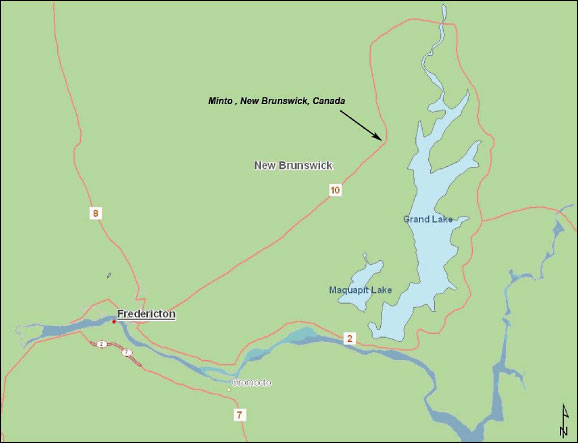Case Study as part of a Web-based
Technical and Regulatory Guidance
Fire Road Mine
Sunbury, New Brunswick
1. Site Information
1.1 Contacts
Michele Coleman
Telephone: 506-327-2228
E-mail: [email protected]
1.2 Name, Location, and Description
The Fire Road Mine is located in Minto, Sunbury, New Brunswick (Figure
1-1), 13 km off a major road. A surface coal mine covering 100 hectares (ha)
was operated 1982–1985. The coal was located under 10–20 m of overburden and
is located in an area of predominantly sandstone and conglomerate with visible
pyrite nodules. The mine was reclaimed using less porous materials than the
surrounding host rock. Therefore, groundwater and surface water flow preferentially
through the waste rock. The acid mine drainage (AMD) is characterized by a
pH of 3.5 and high concentrations of iron (10 ppm) and aluminum (60 ppm). The
flow varies from less than 300 gallons per minute (gpm) to approximately 2400
gpm during spring runoff.

Figure 1-1. Map of Fire Road Mine, Minto, New Brunswick. Source: ArcGIS Desktop Version 9.3.1.
2. Remedial Action and Technologies
A hydrated lime water treatment plant was constructed in 1986 to treat the
AMD using chemical precipitation. The discharge is being treated pursuant
to the Clean Water Act and to mitigate the ecological risk. Primary contaminants
include acidity, aluminum, and iron. The performance of the treatment process
is evaluated by monitoring the treatment pH. Additional testing of fish lethality
of the effluent is performed three times per year. Beginning in 1992, the
sludge generated from the chemical precipitation process has been recycled
to the waste rock to reduce the consumption of lime by approximately half.
Each time the sludge is recycled to the waste rock, an increase in pH and
decrease in aluminum and iron concentrations are observed.
3. Performance
Coal mine water has 3.5 pH. Hydrated lime is used to neutralize the acidity.
Aluminium and iron contaminants are then precipitated.
4. Costs
Capital costs for the chemical precipitation process were reported at $50,000
per year. Ongoing operation and maintenance costs are approximately $300,000
per year.
5.
Regulatory Challenges
None encountered.
6. Stakeholder Challenges
No information available.
7. Other Challenges and Lessons
Learned
As noted above, the sludge is recycled into the waste rock. The increase
in pH and drop in aluminum and iron concentrations follow and spike after
each dredging cycle. Lime consumption has been reduced by over half since
this started in 1992.
8. References
No information available.
